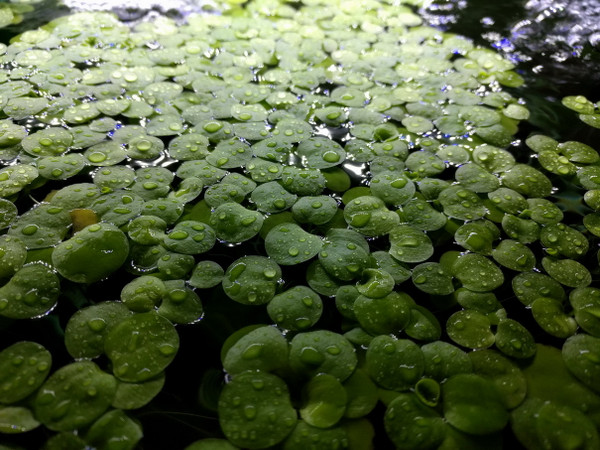Frogbit
Frogbit: The Aquatic Plant that's Taking Over America's Waterbodies
Are you tired of seeing green, slimy water in your ponds or waterbodies? Are you worried about the negative effects of invasive species on the local ecosystem? If so, then you might be interested to learn about frogbit, an aquatic plant that's causing trouble in many parts of the US.
Frogbit can quickly cover the surface of a pond or lake, matting together and blocking sunlight from reaching the water below. This can lead to a range of negative consequences, including decreased oxygen levels and even fish kills. Additionally, the dense mats of frogbit can make it difficult for other aquatic plants to grow, which can impact the entire food chain of the area.
So, what can be done about frogbit? First and foremost, it's important to prevent the spread of this invasive species by cleaning boats and other watercraft before moving them between bodies of water. Additionally, manual removal of the plant is a common control method, although this can be a time-consuming and challenging process.
To sum up, frogbit is a problematic invasive species that can negatively impact the local ecosystem of bodies of water and their inhabitants. However, there are steps you can take to help prevent its spread and control its presence if necessary.
The Different Types of Frogbit and Their Characteristics
There are several different species of frogbit commonly encountered in the US, but they all share certain characteristics. Frogbit is a free-floating aquatic plant that has rounded leaves with spongy undersides, which provides buoyancy. Frogbit is popular amongst aquarium enthusiasts as it is easy to take care of and can provide a cover over open water; this allows fish a place to hide and feel safe. Additionally, the plant produces a myriad of delicate white flowers which can add to the plant's charm.
Personally, I have had experience with Amazon Frogbit in my aquariums. It's a simple plant to grow and I love watching my fish nibble on it.
Controlling the Spread of Frogbit
In order to control the spread of frogbit, it's important to practice good hygiene when working around bodies of water. This can include cleaning boats, gear, and equipment before moving between waterbodies. Additionally, manual removal of frogbit can be an effective means of controlling its spread, although it can be time-consuming and difficult. If manual removal isn't possible, herbicides may be effective; however, it's important to use these products both safely and legally, as some herbicides can be harmful to other aquatic life and the environment.
The Benefits of Frogbit in an Aquarium
While frogbit can be a problematic species in natural bodies of water, it can be a beneficial addition to a well-maintained aquarium. As mentioned before, frogbit provides cover for fish and can help aquarium ecosystems thrive. Additionally, the plant can help to remove nitrates and other pollutants from the water, which can improve water quality for your fish and other aquatic inhabitants.
The Perfect Way to Care for Frogbit
Frogbit is a relatively easy plant to take care of; however, it still requires some basic maintenance. One of the most important factors is lighting: frogbit will thrive in moderate to high light conditions, so make sure that your aquarium is well-lit. Additionally, it's important to fertilize the plant regularly to ensure that it has access to the nutrients it needs. Finally, keeping the plant's roots trimmed can help to keep it under control and prevent it from taking over your aquarium.
Frequently Asked Questions About Frogbit
Q: Can frogbit be eaten?
A: While some people have consumed frogbit in the past, it's not advisable due to the potential for contamination from pollutants and other harmful substances.
Q: Will frogbit kill other aquatic plants?
A: Frogbit can be a problematic plant for other aquatic species, as its dense mats can smother other plants and prevent them from accessing light and other resources.
Q: Is frogbit legal?
A: While frogbit can be a problematic invasive species, it's not illegal to possess or grow this plant in most states. However, it's important to be aware of the potential negative impacts of frogbit and take steps to prevent its spread.
Q: How quickly can frogbit take over a waterbody?
A: Frogbit can reproduce rapidly, and a single plant can produce up to 50 daughter plants within a few weeks. This can quickly lead to exponential growth and the formation of dense mats on the water's surface.
Conclusion of Frogbit
Frogbit is an invasive species that can wreak havoc on local aquatic ecosystems if left unchecked. However, with proper management techniques, it's possible to control the spread of this plant and prevent it from negatively impacting native flora and fauna. Additionally, frogbit can be a beneficial addition to a well-maintained aquarium, providing cover for fish and removing pollutants from the water.
Gallery
Amazon Frogbit - SoShrimp

Photo Credit by: bing.com / frogbit amazon plants
Invasive Frogbit Continues Michigan Spread With New Infestations

Photo Credit by: bing.com / michigan frogbit plant lakes aquatic found invasive mlive frog inland bit
Frogbit (Hydrocharis Morsus Ranae) - Plants For Ponds

Photo Credit by: bing.com / morsus ranae frogbit pond plants next
Frogbit (Limnobium Laevigatum) – Plantek Lab – UK Grown Live Aquarium

Photo Credit by: bing.com / limnobium laevigatum frogbit
Help! Frogbit Invaded By Aphids. What Is A Safe Way To Get Rid Of Them

Photo Credit by: bing.com / frogbit aphids invaded safe way help rid harming fish without them comments plantedtank
